He kept his promise to the little old lady that sold him this stunning 1967 AMC Marlin.


Bob Wunrow still feels a touch of guilt when he recalls buying his lovely 1967 AMC Marlin from the original owner. He didn’t mean to fleece the little old lady that was selling the car. It sort of happened by accident.
“When I saw it for sale, she said she wanted $350 for it, and I said ‘Oh, $350?’ thinking that wasn’t very much,” recalls the resident of Wisconsin Rapids, Wis. “And she said, ‘Well I’ll take $300 then.’ Then I couldn’t get my money out fast enough!”
Even though the car had some rust issues and was going to need some work, Wunrow was thrilled with his low-budget purchase. He is a true AMC enthusiast and the perfect second owner for a car that was obviously loved and cared for by the woman who drove it home from the dealer showroom.
Before he got the car home, though, Wunrow had to make a promise.
“When I came back to get it there was a note on the car that said, ‘Bob, when you restore this car please bring it back and show me.’ I had told her I was going to restore it because there had been a couple holes in the front fender and some rust problems. It needed to be restored.”
It took a while, but Wunrow held up his end of the bargain.
“It was almost seven years to the day,” he says. “I called up the number not knowing if she was still alive and the husband said yes, she’s still alive and she keeps asking, ‘When is that fella gonna bring back my Marlin and show it to me?’ When I came over there she was still in the same house and he wheeled her out and she was on oxygen and everything and she was so happy to see it. We opened all the doors and trunk and everything and she said it looked like brand new. I was really happy I got to show it to her. Then I read in the paper a few months later that she had passed away … but for several years after I would always see her husband around and he would look at it.”
By the time Wunrow adopted the Marlin, he was already a confirmed AMC fan. The Kenosha plant where the cars were made was only about three hours away from his home and Wunrow got hooked on them at a young age.
“My first car was a ’68 Ambassador, and I sold it when I bought my new ’77 Hornet AMX, which I still have,” he says. “I loved that Ambassador so much that I wanted another one and I then I saw the Marlin, and I always loved the Marlins, too. This is built on an Ambassador frame and the front is like an Ambassador so I just got hooked on that …I always liked the Ambassadors and when I was a kid I spent my summers in Kenosha and my uncle worked for American Motors and that was the first time I saw a Marlin.”
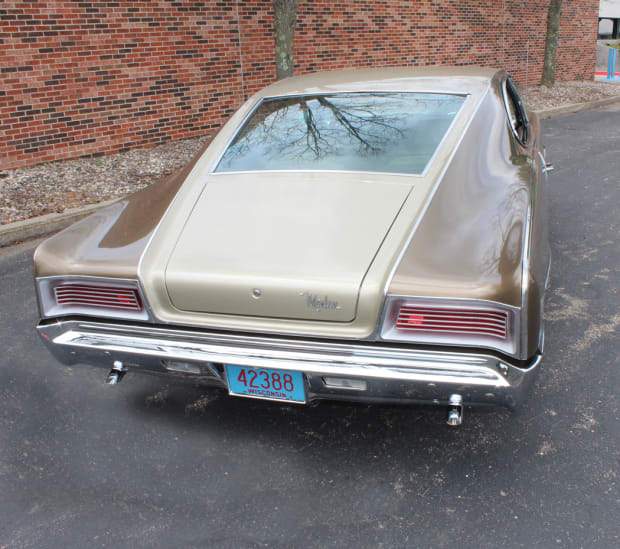
UNCHARTERED WATERS FOR AMC
American Motors Corp. was venturing down a new path in 1965 when the company launched its mid-size Marlin hardtop coupe. At the time, the company had rarely strayed from its blueprint for small, practical, inexpensive compact cars.
This Marlin was something completely different — a curvy, handsome blend between a family car and the sports and muscle cars of the era. It was hard not to compare it to the Charger with their calling-card fastback rooflines. Where the Charger quickly became known as a muscle machine, the Marlin was something of a “tweener” — which should have made it appealing to different audiences, but instead probably hurt sales in the long run.
“Seeking a corner of this market untouched by the competition, AMC emphasizes Marlin as a sports-personal car for the entire family,” Motor Trend magazine opined. “This isn’t quite the contradiction in terms that it seems, for the head of the family spends a fair part of the day alone in the car. It is the only sports/ personal car capable of transporting six adults, so a family with several children does not have to be a 2-car family, though it probably will be anyway.”
For 1967, the Marlin was bigger and smoother looking, and the wheelbase grew by half a foot to 118 inches — sharing the same platform as the Ambassador. The hood was longer, the rear fenders featured a “Coke-bottle” profile and the lines of the Marlin were very Charger-like.
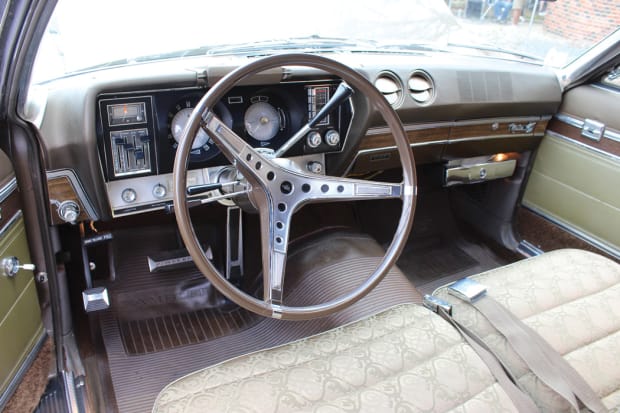
There were smoother body sides, a new rectangular gas filler door and Rally lights incorporated into the grille. Side marker lights could be seen on the trailing edge of the rear fenders, just ahead of the wraparound rear bumper ends. A full-length lower body molding followed the pattern seen on Rebels, arching over both wheel housings. The round medallion was removed from the trunk lid for 1967. The forward edges of the front fenders were decorated by V-shaped badges.
The cars came with one of three base engines: a 199-cid six-cylinder rated at 128 hp; 232-cid six-cylinder rated at 145 hp; and a 287.2-cid V-8 — called a 290 by AMC — rated at 200 hp. Buyers who wanted most gusto could upgrade to a four-barrel 290 rated at 225, or a 343-cid V-8 rated at 235 hp for the two-barrel or 280 hp for with a four-barrel.
A three-speed manual transmission was the base offering. Adding overdrive was a $115 upgrade on the Marlin. Bench seats were standard, and you had to pony up about $280 extra if you wanted buckets and a center console.
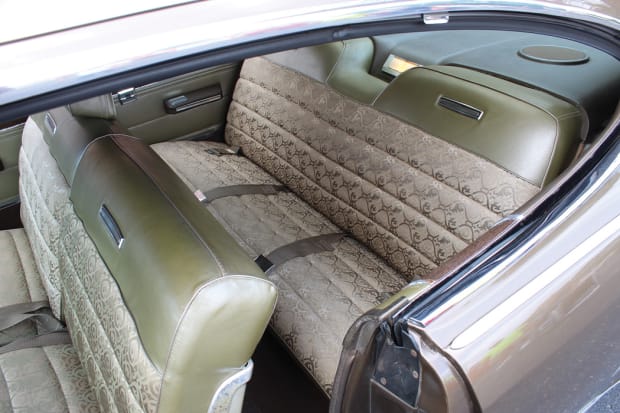
Other noteworthy Marlin options included Adjust-O-Tilt steering, cruise control, 8-track stereo, air conditioning, electric clock, tachometer and vinyl upholstery, which was actually a $15 upcharge. The base factory price for the six-cylinder Marlin was $2,668. The 290 V-8 was about 100 bucks more.
Along with its sloping rear profile, perhaps the Marlin’s most distinctive feature was its tiny trunk lid. The curved deck lid was squeezed between the two large tail light assemblies and below the huge rear window, leaving plenty of room inside for cargo, just not much of an opening to get at anything.
For all its sporty styling cues and sleek silhouette, the Marlin probably rode and handled more like a big ’60s cruiser than a performance car. Measuring more than 201 inches from tip to tip and weighing at more than 3,300 lbs., it was not a bantamweight machine.
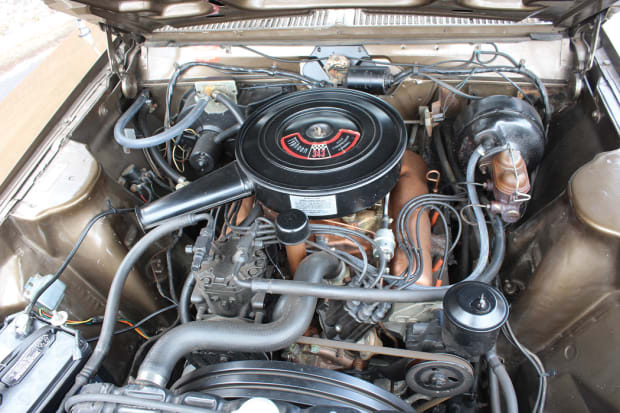
In the end, only 17,419 Marlins rolled off the assembly line, including just 2,545 of the 1967 versions. In a tale that was similar to a lot of models made in the AMC family from the late 1950s through the early 1970s, the Marlins just never quite had enough corporate stability and enough marketing push to last very long.
“They stopped production on Dec. 31 of 1966. When 1967 started they had already ceased production of the ’67 Marlins,” Wunrow pointed out. “The Javelin was coming out and they were going to save their money for that, I guess. According to [the local dealer], this was the only ’67 Marlin he ever sold. He only got one in and that was it.”
44 years and counting…
Other than some rust issues on the front half of the car, Wunrow says his Marlin wasn’t a particularly difficult restoration project. The car had 88,000 miles on it and had suffered some of the ravages of Wisconsin winters, but mechanically it was excellent and the interior as like new.
By far the biggest challenge was figuring out what to do with the rocker panels — or lack thereof.
“The rocker panels were completely rusted off. There were no rocker panels. Behind the wheels, it was actually gone,” Wunrow chuckles. ““I used to work at Freeway and there was a guy that worked there that was a good punch-press, metal bending man and it was hard to find panels and stuff so he actually restored it for me. He actually made the rocker panels for me. He restored a lot of cars … Nowadays you can probably find the replacement panels, but back in 1985 there wasn’t much. He said he could do all that and repaint it. It was probably a good deal, he charged me $700 in 1985!”
“He painted the car, put all the metal in there. I bought the fenders, so he didn’t have to do those. The interior is basically the way I bought it. We never had to do anything with the interior. It’s like the back seat was never sat in, and the front was good.”
Wunrow kept the original two-tone color combination of Yuma Tan and Stallion Brown. Almost of all the trim pieces are original, too.
“I never replaced any of the trim work. Luckily it’s not bad. Little by little I did find things like NOS taillights and NOS headlights and directional lights … bumper guards …. It didn’t have a hood ornament when I bought it, so I got that. The local dealer, Johnson & Sons, they actually had a hood ornament in their inventory. I couldn’t believe it.”
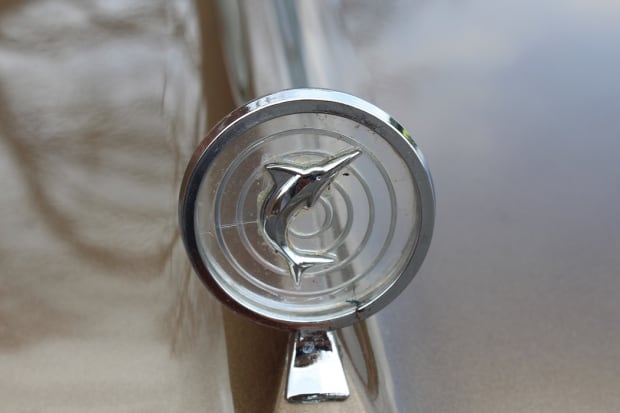
As Marlins go, Wunrow’s car was definitely on the fancy side. It had almost every available AMC option at the time, including air conditioning, tilt steering, power windows and tissue dispenser.
“I did some research and there are only about 5 percent of these cars had the power lift windows. You don’t see many AMC cars from the ‘60s with power windows,” he says. “It only has a headrest on one side .. that’s apparently how they ordered it, with just one headrest. And it does not have cruise control. That’s of the few options it doesn’t have. It’s got an AM radio. It’s a 343 four-barrel, high-compression. And AMC didn’t call it positraction, they called it “power twin wheels”. At a red light if I wanted to I could really smoke the tires because they both turn at the same time. It does have power. And of course it has the dual exhausts, being a V-8.”
“But I really drive it like an old grandpa. I don’t think I’ve heard that chirping sound in quite a few years [laughs].”
Wunrows put new tires on the Marlin this year for the first time since 1987 — the same year he got married.
“This was our wedding car!” he says. “I bought new tires for it when we got married and they were still on it until recently, and they didn’t look too bad.”
Wunrow says his son has already called dibs on the car someday, so it’s highly unlikely the Marlin will be for sale again anytime soon — if ever. It’s lasted 44 years with its second owner and is an orphan that clearly landed with right forever home.
Like the original owner, however, Wunrow does have one request.
“I told my son there’s one thing that he can’t do to it; he can’t put any loud mufflers on it [laughs]. When I will it to him it will have stock mufflers on it, and when he owns it he can’t change the mufflers on it and make it loud.”
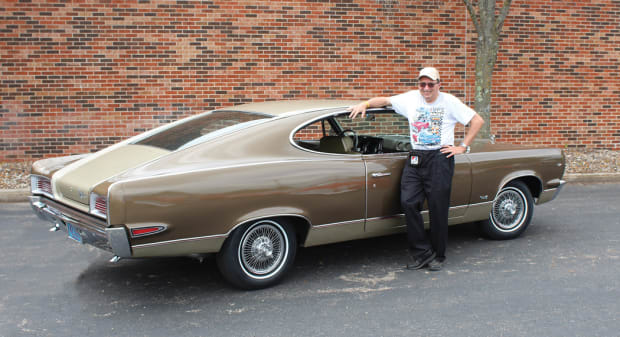
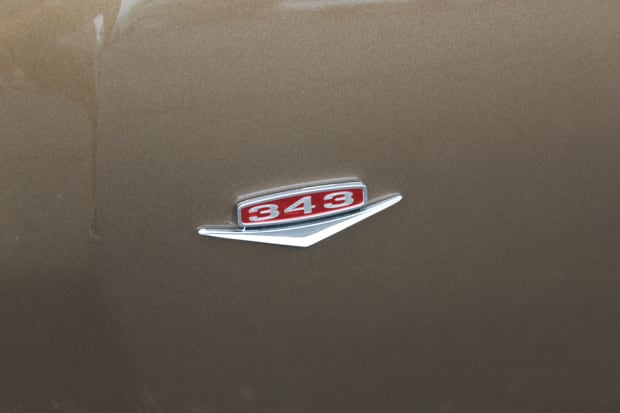

SHOW US YOUR WHEELS!
If you’ve got an old car you love, we want to hear about it. Email us at oldcars@aimmedia.com


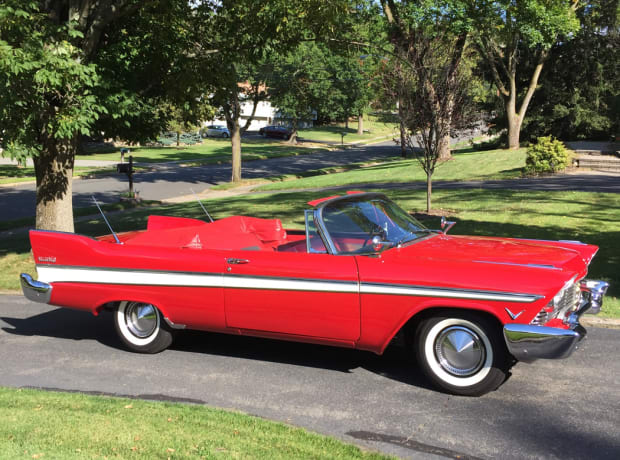

If you like stories like these and other classic car features, check out Old Cars magazine. CLICK HERE to subscribe.
Have you ever wondered what your classic ride is worth? Old Cars has you covered with the Old Cars Report Price Guide. We are your source for unbiased and real-world pricing. Subscribe today and find out what your car is really worth! CLICK HERE to subscribe.

View the original article to see embedded media.
*As an Amazon Associate, Old Cars earns from qualifying purchases.
This is a 1952 Chevrolet step side pickup hot rod that I saw recently at Petrolheadonism Live 2022. What an absolute stunning car, and it really hit me hard with it’s beauty. The car colour, the chrome, the restoration. The Owner and his pal have done a wonderful job on the car. Here’s some information on this car in the owners own words.

The owner (Clive Hardy) purchased this Chevy for £500. What he got was a body shell and a pile of parts and no running gear. It took him, with his good friend Rob Clarke, 12-years to achieve the result you see here today working religiously every Saturday afternoon and Sunday morning. Clive decided that with so many missing components the only sensible solution was to turn it into a hot rod. The pickup is painted in Kandy Apple Red from House of Kolor by OCS Paints at Northampton. The truck has been painted this colour in hidden places like under the hood (bonnet), under the sills and under the fenders (wings). Apart from the gorgeous colour the other striking visual difference is the lowered roof line. Rob and Clive deliberated how much metal to remove to chop the roof, 3 or 4 inches. Clive chose to go with 4 inches as this still left plenty of headroom in the cab.

As the Chevy came with no running gear they fitted a brand new 350ci Chevy engine with 4 barrel Holley carburettor and an Edlebrock intake manifold. The engine is coupled to a Jaguar IRS rear axle with a Salisbury differential. New adjustable shock absorbers and suspension complete the picture. At the front end a new Camaro front clip complete with new springs and gas shock absorbers was fitted, together with new rack & pinion power steering. In actual fact every item is brand new on this pickup with the only exception being the chassis.

Advance-Design was a pickup truck series by Chevrolet, their first major redesign after WWII. It was billed as a larger, stronger, and sleeker design in comparison to the earlier AK Series. First available on 28th June 1947 these trucks were sold with various minor changes over the years until 25th March 1955, when the Task Force Series trucks replaced the aging Advance-Design model.
The same basic design family was used for all of its trucks including the Suburban, panel trucks, canopy express and cab-overs. From 1947 until 1955, Chevrolet trucks were number one in sales in the United States, with rebranded versions sold at GMC locations. There are three main sizes of this truck: the half-ton, three-quarter- ton, and full ton capacities in short and long wheelbase. The 3100 designates this as a half ton truck.

The differences for the 1952 model year were the outer door handles were now the push button type as opposed to the previous turn downstyle. The speedometer was changed to read to 90 mph and dashboard trim was painted instead of chrome. Mid-year Chevrolet stopped using the 3100-6400 designation on the hood and changed the window and wiper knobs to a maroon colour. The original engine was a 216ci straight 6 with a 3/4 speed manual transmission.
Length 196,6”(4,990mm).

Bravo to Clive and Rob, what a wonderful car. I loved it. If you are ever down in the Berkshire region I’d love a drive out. All the best.
You can read more about Petrolheadonism Live here.
Make sure that you are subscribed to our newsletter (see below link) or following us on social media (@mycarheaven) to be updated of our competitions and more. Recent competitions have included winning tickets to Silverstone Classic to Concours of Elegance and to Petrolheadonism Live and you can be in with a chance of winning tickets to the NEC Classic Motor Show HERE.
See you around.

The post The beautiful 1952 Chevrolet 3100 Pickup appeared first on My Car Heaven.
Here’s another Top 10, this time we bring you our top 10 cars from the 2022 Concours of Elegance. We have put these cars in order of which cars we’d most like to own/ drive. See what you think.
1971 Lamborghini Miura SV

I just love this car. I love the shape. I love the story about Lamborghini going up against Ferrari. I love the two tone colour. This car looks like it’s been restored to a standard it’s probably better than when it was new. Read more about this actual car here, and more Miura posts here.
.
1961 Aston Martin DB4 GT Zagato

Has anyone who knows me, follows me, or has read any of my previous articles, will know, this car, in my opinion, is one of the most beautiful cars of all time, if not the No.1. This particular car sounds monstrous, which further appeals to me. Read more about this actual car here, and more DB4 GT Zagato posts here.
.
1956 Maserati A6G Zagato

Stunning. I cannot believe anybody would think this car is not a masterpiece of automotive design. It looks lovely. It sounds lovely. With Zagato bodywork, which in my opinion is one of the most beautiful car designers of all time, this has to be one of the most beautiful cars of all time. Here’s more information on the car here.
.
1933 Delage D8 S Coupe Letourneur et Marchand

Wow, just wow. What an amazing looking car. Immaculate paint work in black with chrome detailing. The car sits quite low and we love it. Sinister looking don’t you think? Here’s more information on the car here.
.
1938 Delage D8-120 ‘de Villars’

Wow. Just a beautiful looking car. It’s very distinctive fenders and curves. What a beautiful looking car. Here’s more information on the car here.
.
1994 Bugatti EB 110 SS

I just love this car. It’s not often you see this car. But grey with blue interior just works. I believe it’s a beautiful looking car. It is immensely loud, which we love, very rare, which we love, a rare car and we would so so so love to drive one. Here’s more information on the car here.
.
1938 Hispano-Suiza H6B Dubonnet Xenia

Just amazing. Have you ever seen anything like this in your life. This is truly something out of this world. The lines the detailing the paintwork, the chrome, just looks unbelievable. Here’s more information on the car here.
.
1927 Avions Voisin C14 Lumineuse

Have you ever seen a car like this. This beautiful and distinct looking car was up for sale via Gooding and company, with a without reserve price to £275,000-£350,000, and sold for £202,500. You’d probably love or hate this car, but we love it. Here’s more information on the car here.
2021 Bugatti Divo

What a menacing and beautiful looking car. I love the colour of the paint work, it’s like a matt fluorescent yellow. I had to include this car as it is a true drivers car/ hypercar and I’d so love to drive it. Here’s more information on the car here.
.
1930 Cord L-29 Brougham

What an exceptional looking car. The L-29 was the first American front wheel drive car to be offered to the public. Love it. Here’s more information on the car here.
.
So there you have my top 10. So hard to choose 10 when every car on display is stunning, a work of art. A little more…
A few unusual looking cars, that I’ve never seen before, that I thought you (like me) could like:
1953 Bristol 404 Coupe

What a beautiful looking car. What lovely lines. A very odd fin at the back of the car. Have you ever seen a car like this. Here’s more information on the car here.
.
1963 ATS 2500 GT Coupe

I imagine this is a very rare car. Paintwork is exceptional as you would expect from any concours car. Beautiful shape. Lots of chrome. A wonderful looking rear end. We love it. Here’s more information on the car here.
And last, we had to feature this…
.
1963 Ferrari 250 GTO

Of all the many legendary Ferraris, without question the most iconic is the 250 GTO. Designed to take the fight to the AC Cobra, Jaguar E-type and Aston Martin DP214 in Group 3GT racing, the car harnessed the talents of golden era Ferrari engineers such as Giotto Bizzarrini and Mauro Forghieri. This particular car is chassis 4219GT, and you can read more about it here.
I hope you liked this article. Leave a comment below, what’s your favourite car from the above? See you around…
The post Our Top 10 desired cars from the Concours of Elegance 2022 appeared first on My Car Heaven.
This past weekend we attended the Stratham Hill Car and Bike Show for BSA Troop 185. Since I was a
The post Went to the Stratham Hill Car and Bike Show for BSA Troop 185 – Good Car People appeared first on NewEnglandAutoShows.com.
See the world with Gray Line Motor Tours. The story of The Grey Line Motor Tour Company.
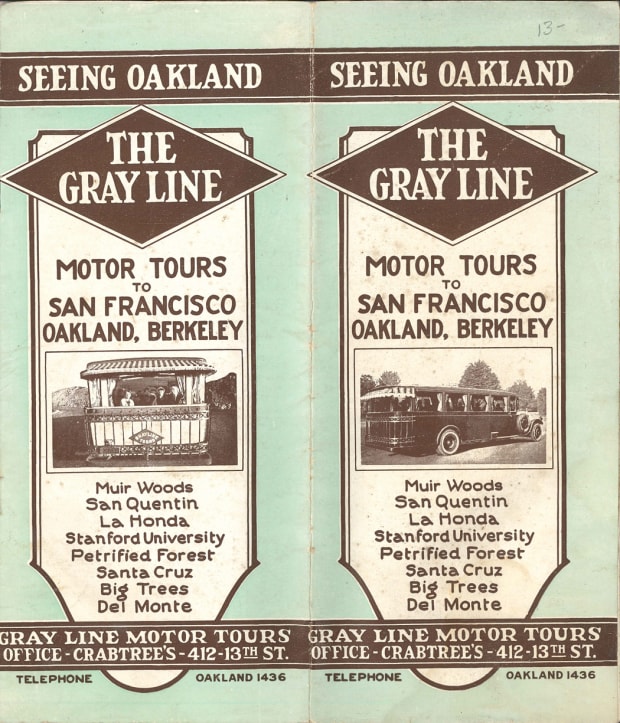
Some of the most opulent vehicles made by man were the carriers of the wealthy and adventuresome. We could elaborate on the virtues of Pierce-Arrows, Packards and endearing Peerless cars with custom workmanship. We could linger on the special-order designs for Cadillac and Lincoln, Stearns and Stutz, and a rafter of other names that have traced the advancement of motoring. We would additionally pontificate on the results exquisitely executed by specialty design houses of absolute character. We could envision the one-offs, true sole creations and rare survivors covetously collected today. We could add the multi-million-dollar motorcars that furthered the cause of motor creation. Even if we mentioned all these, we would still be remiss by neglecting mention of the largest classy customs ever to take to the road.
Hence, this installment.
In 2011, The Gray Line of motor tours reached its century mark. Its humble beginning dated to March 1910, a time when the roads of America were rough, at best; basic and rutted, in general; and, at times, impassable. But a fever had caught ahold of Americans. It was a wanderlust, an inner desire to see the land, to see what lay beyond the sunset and on the other side of the mountain. That temptation was destined to grow as the demand for personalized motor transport likewise rose. From 1910 through the 1920s, Americans discovered travel, and the nation would never be the same.
The Gray Line vision was masterminded by Louis Bush, who took an old Mack Truck chassis and made something special of it. He limited sightseeing trips to the Washington, D.C., area, and decided to paint the unit in blue and gray, colors popularized in American history during the Civil War. It wasn’t long before 1926 beamed its light and other large cities were added to the touring list. There was New York, a magnet for eastern travel. In the Midwest, Chicago cast its spell, and the automotive capital of Detroit was hardly far behind. New Orleans catered to the south while Los Angeles and San Francisco motioned for tourists to realize their spell. Add international sites such as Toronto and Havana, and you get a better picture of the meaning behind the wanderlust. The demand for custom-designed buses to experience these places in luxury was on the rise.
All this continued to mature as Harry J. Dooley took the reins of leadership in the post-World War I economy and boomed even more. He earned the accolade as “father” of the sightseeing industry.
To capture the feel of this advancement in the 1920s, let’s hitch a ride hither and yon.
For the novice, custom appointments were conducive to touring. An exterior view of the landscape was shrouded by a canopy and trimmed with decorative railing, as if an observation deck on the rear car of a train. Curtains with pullbacks graced each side-window post as open windows beckoned scenic scents to invade the lives of passengers. The buses were more than transportation; those were magic rides to vistas unknown to many travelers. That was a time when travel was an opulence, but one which more and more people were discovering.
Sidemounted spare tires added a classy air to the bus’s exterior, and large whitewall tires dressed up the affair. A wide range of stops enticed travelers. On a motor tour to San Francisco, Oakland and Berkeley, visits were made to Muir Woods, San Quentin, La Honda, Stanford University, the Petrified Forest, Santa Cruz and Del Monte. There were deluxe versions of western tours and smaller ones. For example, the Golden Gate Park, Cliff House and Presidio, or “Thirty-Mile Drive Tour De Luxe,” offered magnificent views of San Francisco from the summit of Twin Peaks. In 1927, it was a mere $2.50 fare. Passengers were picked up at and returned to hotels with no extra charge — quite a value in the Roaring Twenties.
The bus-building business had become a notable aspect of motorized progress. Magazines were issued on the subject, travel guides were released and design work gained momentum. Not all buses were brimming with ultra-comforts, but (as in the more recent age of custom vans and motor homes) builders and designers wanted a little extra they could offer customers to such a distinct advantage that business swung to the makers that were most innovative.
Building on the best of tour destinations was the Santa Rose and Petrified Forest Tour, called Trip #6 in a 1927 booklet by The Gray line. Fare was $10.50. This tour appealed “to the true lover of Nature” once the half-hour drive over the Golden Gate had been accomplished. Areas rich in orchard and vineyards beckoned. “Here is the Valley of the Moon, made famous by Jack London,” said The Gray Line copywriter. “It was in this region on June 14, 1846, the famous Bear Flag was raised proclaiming the California Republic.”
Less we forget, farmers liked to take tours. To see Sonoma County’s rich poultry area (that, in 1927, was producing more than $6 million in poultry income annually) had to trigger new ideas among those touring farmers. It was site to the largest hatchery in the country, “one incubator plant hatching 165,000 chicks at one time.”
On the lesser side of cost was a “See Chinatown After Dark” tour for an affordable $1.50. Near the top end was a fare of $12.50 to see Santa Cruz and Del Monte, a two-day excursion by bus. Even more could be seen on a three-day $47.50 plan including meals as riders explored major lengths of California. The Gray Line was shrewd in coupling with the Railroad Commission of the state by also encouraging tourists to partake of rail tour in a deluxe parlor car with “individual arm chairs seats, reserved for the entire trip, with hotel and meal accommodations at the finest hotels on the Pacific Coast.”
For thousands of early travelers, The Gray Line was their first experience in long or short tours.
The experience on buses designed to provide a degree of comfort and ease of mind was a strong taste of the luxury car field that was maturing and how, when income allowed, it was in the minds of many to renew their discoveries in classic custom settings, at the steering wheel of their own automobile.
Once people took to touring, there was no stopping the rush of innovation of vehicles with classic custom design.

If you like stories like these and other classic car features, check out Old Cars magazine. CLICK HERE to subscribe.
Want a taste of Old Cars magazine first? Sign up for our weekly e-newsletter and get a FREE complimentary digital issue download of our print magazine.

View the original article to see embedded media.
*As an Amazon Associate, Old Cars earns from qualifying purchases.
Here’s a little information about the beautiful 1963 Ferrari 250 GTO which was on display at the 2022 Concours of Elegance. One of our favourite cars of all time. You can see more Concours of Elegance news, reviews, videos and galleries here.
Of all the many legendary Ferraris, without question the most iconic is the 250 GTO. Designed to take the fight to the AC Cobra, Jaguar E-type and Aston Martin DP214 in Group 3 GT racing, the car harnessed the talents of golden era Ferrari engineers such as Giotto Bizzarrini and Mauro Forghieri.
Though the car largely used tried and tested mechanicals, Bizzarrini employed the latest research from wind tunnel testing at Pisa University to craft a shape to beat the world’s best. Rendered in aluminium by Scaglietti, the 250 GTO weighs between 880kg and 950kg, and is powered by a mighty 3.0-litre Colombo V12 producing 296bhp, sourced from the 250 Testa Rossa Le Mans victor.
This particular car is chassis 4219GT, which was originally sold to Mamie Spears Reynolds, the daughter of former USA senator Robert Reynolds and Evalyn McLean Roberts of the McLean mining company, which once owned the Hope Diamond. Luigi Chinetti not only sold the car, but gained a daughter-in-law- his son, Luigi ‘Coco’ Chinetti Jr, married Mamie in July 1963. The car duly won that year’s Daytona 3-hour Continental with Pedro Rodríguez behind the wheel, and finished fourth in class and 13th overall at the ’63 Sebring 12 Hours with Joakim Bonnier and John Cannon driving.
Mamie’s ownership didn’t last long (neither did the marriage to Coco, which was over by 1965), with Buick and Ferrari dealer, Beverly Spencer, purchasing it in May 1963. He changed the original Rosso Cima paintwork to white with blue centre stripes, as he campaigned the 250 GTO as part of the North American Racing Team (NART). The car was driven by Frank Crane at Laguna Seca, Pacific Raceway and Candlestick Park Raceway, notching up a podium and a class victory along the way.
By the end of 1963 Bev Spencer put the car up for sale again, advertising it for $14,000. George C Dyer Snr of Hillsborough, California, bought the Ferrari early the following year and hung on to it until January 1993, when the current owner, a Mr Brandon Wang took stewardship. Since then it’s been a regular at the Goodwood Festival of Speed, Tour de France Auto and Pebble Beach Concours.
The post The Beautiful 1963 Ferrari 250 GTO (#4219GT) appeared first on My Car Heaven.
You can only have a car original once. This 1967 Mustang fastback lives by that credo.
By Rob Staple

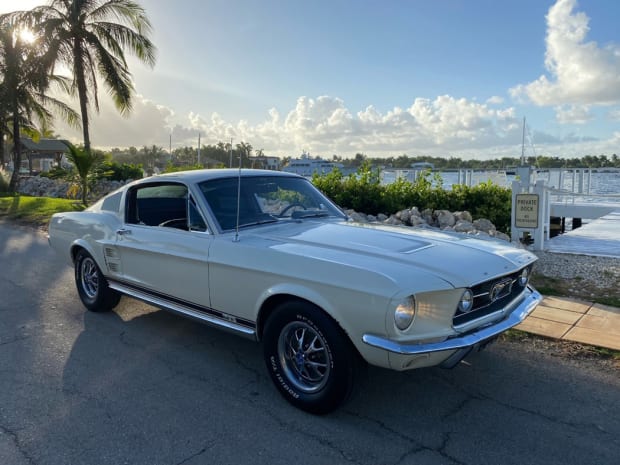
The Ghost 67 Fastback Mustang survivor
You can only be original once is the phrase you have probably heard a million times. Now what’s the important thing behind that phrase is the fact that factory original cars, cars that are still the way they rolled off the factory assembly line when they were born, are quite rare.
The fastback in ’67 itself is not rare, they made 71,000 of those cars, thousands of them still survive and it’s not hard to find one, now finding one that is a true survivor that is substantially the way it came from the factory and has not been restored… Now that’s a rare thing!

Finding one of those that is also a GT model that’s something even much rarer, it would be a fraction of the entire population of those cars made and still surviving. We have one right here, it is a 1967 mustang fastback factory GT and it’s substantially the way it came from the factory, it’s un-restored and well preserved. When you look at the paint it tells the story. The interior, engine bay, trunk and the undercarriage appear to be direct from the factory. You can see that patina that only comes with the earned decades of use. Preserved cars are becoming all the more popular these days and are finally getting the attention they deserve.
It’s had a little paint work mostly to spruce up the interior. The headliner and carpet are completely original, and the engine bay is presented much like it was when it left the factory as is the trunk and the undercarriage. It’s been very well preserved, there’s been no attempt to restore this car. It remains in fantastic condition for a 55-year-old Mustang.
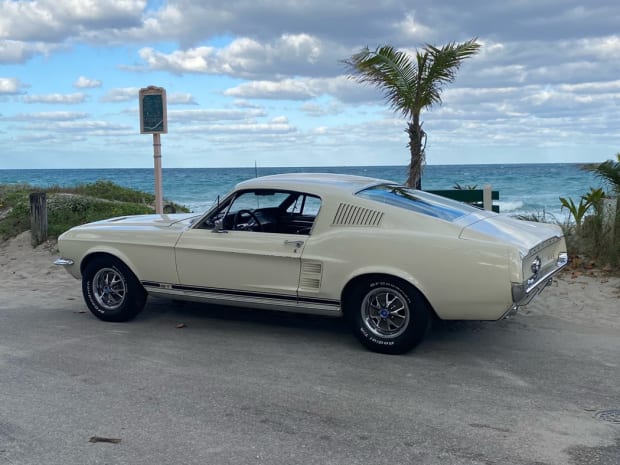
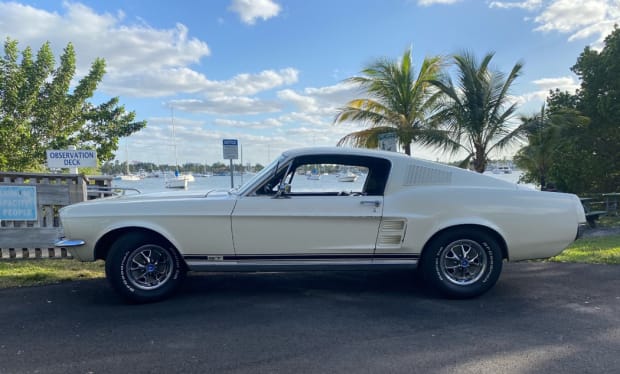
This particular ’67 Fastback GT is distinct in many ways, very rare to find a C code 289 cid 2-barrel carburetor GT with a three-speed manual. This was the only year you could order a GT with these options, making it a super rare, super special car.
I’m the second owner. The car was manufactured in Dearborn, Michigan, but the Ghost spent most of its life in Wichita, Kansas. Originally owned by decorated Korean War Veteran, Chief Master Sergeant Donald Dean Neal. It was preserved after his passing in 2007. The original owner drove from Kansas to South Dakota which would explain the uniform paint wear. The car was purchased from Michael Chance at Myrod.com who only sells cars of the highest quality. It was found by a bird-dog of his that finds the rarest cars. The car will be preserved in its current condition with only minor cosmetic attention for preservation purposes.
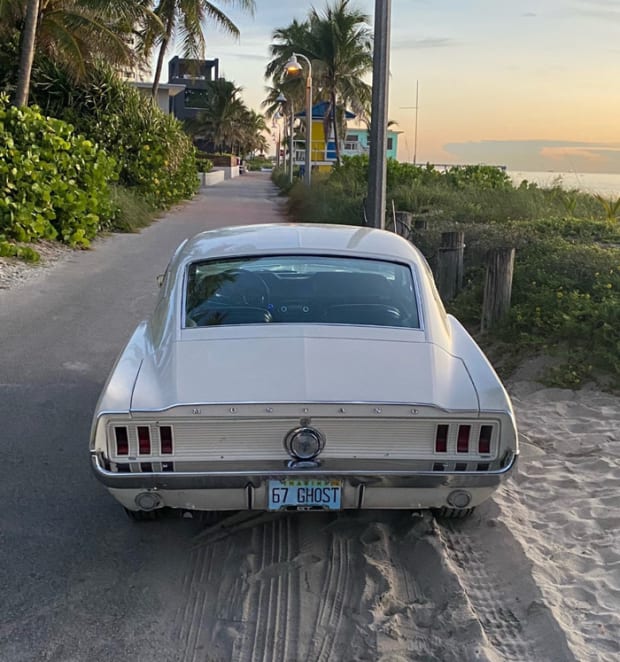

SHOW US YOUR WHEELS!
If you’ve got an old car you love, we want to hear about it. Email us at oldcars@aimmedia.com
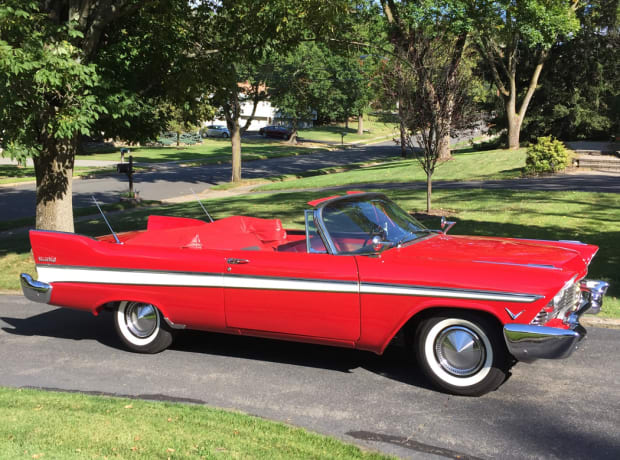
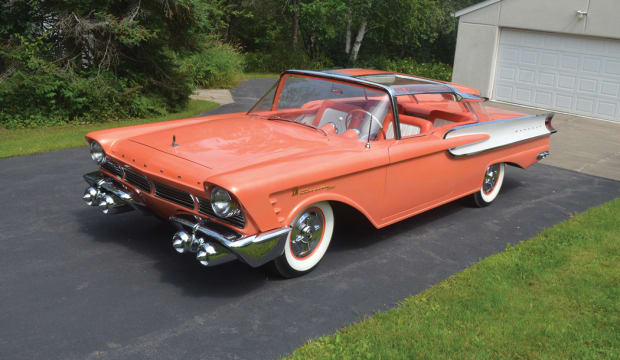


If you like stories like these and other classic car features, check out Old Cars magazine. CLICK HERE to subscribe.
Want a taste of Old Cars magazine first? Sign up for our weekly e-newsletter and get a FREE complimentary digital issue download of our print magazine.

View the original article to see embedded media.
*As an Amazon Associate, Old Cars earns from qualifying purchases.
Here’s an excellent snapshot of our supply chain problem. Not only is its fragility responsible for an unmanageable part of inflation, just-in-time optimization has spoiled investors and consumers. Impulsive behavior is rewarded but it also crashes the system. Another casualty are we, who used to enjoy driving our cars. There is no lane discipline, trucks … Continue reading “Interstate Misery”
The post Interstate Misery appeared first on My Blog.
Reggie Jackson was selling this one below on Bring a Trailer (BaT) on October 12, 2021. GM only made 602 in 1967 to homologate them for the TransAm race series. Only about 230 of those are known to survive. For 1968, GM officially introduced the Z/28 option as a “model.” That’s why those badges are … Continue reading “My Personal Best Speeding Ticket with a Chevrolet Camaro Z/28”
The post My Personal Best Speeding Ticket with a Chevrolet Camaro Z/28 appeared first on My Blog.


